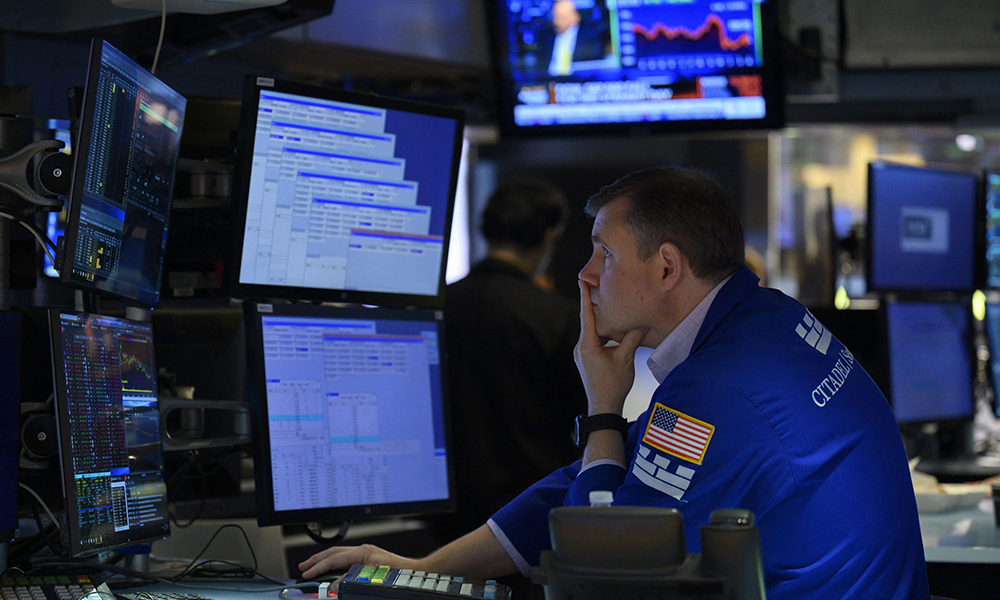 图片来源:ANGELA WEISS—AFP/GETTY IMAGES
图片来源:ANGELA WEISS—AFP/GETTY IMAGES全球商业领袖在过去几年里需要应对诸多挑战,如新冠肺炎疫情、俄乌冲突、通货膨胀和地缘政治不确定性,他们无法做出未来会更容易或是情况更为熟悉的假设。相反,未来十年的经济、银行业和投资格局可能会与近期的情况截然不同。
从经济上讲,21世纪是不同寻常的。“全球资产负债表”是对整个世界经济的核算——计算家庭、公司、政府和金融机构的资产和负债。2000年之前,资产负债表与GDP实现同步增长。从那以后,资产负债表上的资产增长速度远远超过GDP,股票和房地产等资产创造了160万亿美元的账面财富。实际上,过剩的储蓄无法在实体经济中找到有效的出口,因此投资很少。这导致经济增长缓慢,全球通货膨胀率低,利率下降。
这些趋势现在可能正在消退。投资需求正在上升。例如,在这十年的剩余时间里,在实现净零排放目标的过程中,将需要进行增量投资(估计将占全球GDP的两个百分点)。然后是对新基础设施、更强大的供应链和国防的固定投入。
接下来会发生什么?我们又能做些什么?为了回答这些问题,麦肯锡全球研究院(McKinsey Global Institute)考虑了到2030年全球经济将如何演变的四种截然不同却看似合理的情景。
情景1:情景再现
仅以美国为例,在这种情景下,波动性减弱,经济大致回到2000年至2020年的水平:高储蓄、低通胀、低利率、投资疲弱以及劳动力市场供求大致平稳。生产率和产出增长都很疲软。财富实现持续增长,但代价是实际经济产出减少,不平等加剧。资产负债表相对于GDP有所扩张,仍容易受到破坏。
情景2:回到70年代
不,不是回归厚底鞋和迪斯科。在这种情景下,会出现类似于美国在上世纪70年代经历的滞胀的情况。通货膨胀和短期利率维持在4%左右,压低了包括股票和房地产在内的资产的实际价值。央行必须在抗击通胀与维护金融稳定之间取得平衡。消费强劲,但增长却平平无奇。企业盈利增长缓慢,价格不稳定意味着市场波动的风险很高。实际家庭财富下降。相对于GDP,全球资产负债表回归历史平均水平。
情景3:资产负债表重置
想想房地产/股票泡沫破裂后的日本,1990年至2000年间,其总资产净值相对于GDP缩水了20%。这被称为“失去的十年”,本质上是停滞和衰退的10年,影响了财富、收入和金融稳定。在这种情景下,财政和货币政策会大力收紧,以抑制通胀。资产价格随之下降,给金融机构带来压力。长期的去杠杆化会抑制经济增长,因为消费者在偿还债务而不是进行消费。
情景4:生产力加速
这是唯一能预见收入和财富实现长期增长的情景。加大实际投资以及数字和新兴技术(如生成式人工智能)的部署将提高生产力。GDP实现快速、广泛增长,使得家庭财富增加——仅在美国就增加了16万亿美元。通胀下降,而实际利率平均上升至1%左右,支持生产性资本配置,并改善全球资产负债表的健康状况。在这种强大而稳定的经济中,实际存款会萎缩,央行会退出量化紧缩政策。
这四种截然不同的情景有一个共同点:带来(现实世界)严重后果。根据我们的估计,到2030年,仅在美国,“资产负债表重置”和“高生产率”情景下的家庭财富差距就将达到48万亿美元。GDP增长差距为1.7个百分点。
要为应对如此广泛的可能性进行规划,企业需要超越追踪利率决策或月度通胀数据等短期指标。相反,他们希望为塑造自身所在行业的长期结构性转变进行规划。是否正在实现净零排放的承诺?贸易政策是否会出现变化?哪些国内政策因素最重要?
由于未来是不确定的(而且可能更糟),企业需要加强风险管理。可以采取的行动包括提升股权缓冲能力,强化资产负债表,以及减轻宏观风险。最后,即使在增强韧性的同时,企业也应寻求新增长机会,这可能需要开发新商业模式和能力。
近年来,全球经济经受了一次又一次的冲击。毫无疑问,许多人愿意回到相对平静的时期,如2019年。但事实情况是,这是无法做出假设的。
当然,商业领袖和政策制定者应该努力实现(设想的)最佳情景,即“生产力加速”。但考虑到近期的波动,他们也应该为相对不利的情况做好准备。当涉及到经济时,凡是过去,不一定皆为序章。 (财富中文网)
扬·米施克(Jan Mischke)是总部位于苏黎世的麦肯锡全球研究院的合伙人。斯文·斯密特(Sven Smit)是麦肯锡公司阿姆斯特丹办事处高级合伙人,也是麦肯锡全球研究院的全球负责人。奥利维亚·怀特(Olivia White)是麦肯锡公司旧金山办事处的高级合伙人,也是麦肯锡全球研究院的主任。
Fortune.com上发表的评论文章中表达的观点,仅代表作者本人的观点,不代表《财富》杂志的观点和立场。
译者:中慧言-王芳
全球商业领袖在过去几年里需要应对诸多挑战,如新冠肺炎疫情、俄乌冲突、通货膨胀和地缘政治不确定性,他们无法做出未来会更容易或是情况更为熟悉的假设。相反,未来十年的经济、银行业和投资格局可能会与近期的情况截然不同。
从经济上讲,21世纪是不同寻常的。“全球资产负债表”是对整个世界经济的核算——计算家庭、公司、政府和金融机构的资产和负债。2000年之前,资产负债表与GDP实现同步增长。从那以后,资产负债表上的资产增长速度远远超过GDP,股票和房地产等资产创造了160万亿美元的账面财富。实际上,过剩的储蓄无法在实体经济中找到有效的出口,因此投资很少。这导致经济增长缓慢,全球通货膨胀率低,利率下降。
这些趋势现在可能正在消退。投资需求正在上升。例如,在这十年的剩余时间里,在实现净零排放目标的过程中,将需要进行增量投资(估计将占全球GDP的两个百分点)。然后是对新基础设施、更强大的供应链和国防的固定投入。
接下来会发生什么?我们又能做些什么?为了回答这些问题,麦肯锡全球研究院(McKinsey Global Institute)考虑了到2030年全球经济将如何演变的四种截然不同却看似合理的情景。
情景1:情景再现
仅以美国为例,在这种情景下,波动性减弱,经济大致回到2000年至2020年的水平:高储蓄、低通胀、低利率、投资疲弱以及劳动力市场供求大致平稳。生产率和产出增长都很疲软。财富实现持续增长,但代价是实际经济产出减少,不平等加剧。资产负债表相对于GDP有所扩张,仍容易受到破坏。
情景2:回到70年代
不,不是回归厚底鞋和迪斯科。在这种情景下,会出现类似于美国在上世纪70年代经历的滞胀的情况。通货膨胀和短期利率维持在4%左右,压低了包括股票和房地产在内的资产的实际价值。央行必须在抗击通胀与维护金融稳定之间取得平衡。消费强劲,但增长却平平无奇。企业盈利增长缓慢,价格不稳定意味着市场波动的风险很高。实际家庭财富下降。相对于GDP,全球资产负债表回归历史平均水平。
情景3:资产负债表重置
想想房地产/股票泡沫破裂后的日本,1990年至2000年间,其总资产净值相对于GDP缩水了20%。这被称为“失去的十年”,本质上是停滞和衰退的10年,影响了财富、收入和金融稳定。在这种情景下,财政和货币政策会大力收紧,以抑制通胀。资产价格随之下降,给金融机构带来压力。长期的去杠杆化会抑制经济增长,因为消费者在偿还债务而不是进行消费。
情景4:生产力加速
这是唯一能预见收入和财富实现长期增长的情景。加大实际投资以及数字和新兴技术(如生成式人工智能)的部署将提高生产力。GDP实现快速、广泛增长,使得家庭财富增加——仅在美国就增加了16万亿美元。通胀下降,而实际利率平均上升至1%左右,支持生产性资本配置,并改善全球资产负债表的健康状况。在这种强大而稳定的经济中,实际存款会萎缩,央行会退出量化紧缩政策。
这四种截然不同的情景有一个共同点:带来(现实世界)严重后果。根据我们的估计,到2030年,仅在美国,“资产负债表重置”和“高生产率”情景下的家庭财富差距就将达到48万亿美元。GDP增长差距为1.7个百分点。
要为应对如此广泛的可能性进行规划,企业需要超越追踪利率决策或月度通胀数据等短期指标。相反,他们希望为塑造自身所在行业的长期结构性转变进行规划。是否正在实现净零排放的承诺?贸易政策是否会出现变化?哪些国内政策因素最重要?
由于未来是不确定的(而且可能更糟),企业需要加强风险管理。可以采取的行动包括提升股权缓冲能力,强化资产负债表,以及减轻宏观风险。最后,即使在增强韧性的同时,企业也应寻求新增长机会,这可能需要开发新商业模式和能力。
近年来,全球经济经受了一次又一次的冲击。毫无疑问,许多人愿意回到相对平静的时期,如2019年。但事实情况是,这是无法做出假设的。
当然,商业领袖和政策制定者应该努力实现(设想的)最佳情景,即“生产力加速”。但考虑到近期的波动,他们也应该为相对不利的情况做好准备。当涉及到经济时,凡是过去,不一定皆为序章。(财富中文网)
扬·米施克(Jan Mischke)是总部位于苏黎世的麦肯锡全球研究院的合伙人。斯文·斯密特(Sven Smit)是麦肯锡公司阿姆斯特丹办事处高级合伙人,也是麦肯锡全球研究院的全球负责人。奥利维亚·怀特(Olivia White)是麦肯锡公司旧金山办事处的高级合伙人,也是麦肯锡全球研究院的主任。
Fortune.com上发表的评论文章中表达的观点,仅代表作者本人的观点,不代表《财富》杂志的观点和立场。
译者:中慧言-王芳
COVID-19. War in Europe. Inflation. Geopolitical uncertainty. Global business leaders have had a lot to deal with in the last few years, and they cannot assume the future will be any easier or more familiar. Rather, the economic, banking, and investment landscape of the next decade is likely to look materially different from the recent past.
Economically speaking, the 21st century has been unusual. The “global balance sheet” is an accounting of the whole world’s economy—counting up the assets and liabilities of households, corporations, governments, and financial institutions. Before 2000, the balance sheet grew in tandem with GDP. Since then, the assets on the balance sheet have increased far faster than GDP, as assets like equity and real estate created $160 trillion in paper wealth. In effect, a glut of savings couldn’t find productive outlets in the real economy, so investment was low. That contributed to sluggish growth, low global inflation, and declining interest rates.
These trends may now be fading. Investment requirements are rising. Progressing toward net-zero emissions, for example, will require incremental investment estimated at two percentage points of global GDP for the rest of this decade. Then there are the stated commitments to new infrastructure, stronger supply chains, and defense.
What’s next? And what can we do about it? To address those questions, the McKinsey Global Institute considered four different plausible scenarios for how the global economy will evolve by 2030.
Scenario #1: Repeat performance
Looking just at the United States, in this scenario, volatility ebbs, and the economy goes back to roughly where it was from 2000 to 2020: high savings, weak investment, a not-too-tight labor market, and low inflation and interest rates. Productivity and output growth are both weak. Wealth continues to grow, but at the expense of real economic output and higher inequality. The balance sheet expands relative to GDP and remains vulnerable to disruption.
Scenario #2: Back to the ’70s
No, not platform shoes and disco. In this scenario, there is something akin to the stagflation the U.S. experienced in the 1970s. Inflation and short-term interest rates stick at around 4%, depressing the real value of assets including equity and real estate. Central banks have to balance fighting inflation with supporting financial stability. Consumption is strong, but growth is unimpressive. Corporate earnings grow slowly, and the lack of price stability means a high risk of market volatility. Real household wealth declines. Relative to GDP, the global balance sheet reverts toward historic averages.
Scenario #3: A balance sheet reset
Think Japan after the real-estate/equity bubble burst, when its total net worth relative to GDP contracted by 20% from 1990 to 2000. Known as the “lost decade,” this was essentially a 10-year episode of stagnation and recession, affecting wealth, income, and financial stability. In this scenario, fiscal and monetary policy tightens strongly to bring inflation down. Asset prices contract in response, putting financial institutions under pressure. Prolonged deleveraging dampens growth as consumers pay down debt rather than spend.
Scenario#4: Productivity acceleration
This is the only scenario that envisions long-term growth of both income and wealth. Greater real investment and the deployment of digital and emerging technologies such as generative A.I. raise productivity. Brisk, broad-based GDP growth boosts household wealth–as much as by an additional $16 trillion in the U.S. alone. Inflation falls while real interest rates rise to about 1 percent on average, supporting productive capital allocation, and improving the health of the global balance sheet. In this strong and stable economy, deposits shrink in real terms and central banks roll back quantitative tightening.
These four distinct scenarios have one thing in common: major real-world consequences. The difference in household wealth between the “balance sheet reset” and “high-productivity” scenarios adds up to $48 trillion in the United States alone by 2030, according to our estimates. And the difference in GDP growth is 1.7 percentage points.
To plan for such a broad range of possibilities, businesses need to go beyond tracking short-term indicators like interest rate decisions or monthly inflation numbers. Instead, they will want to plan for the longer-term structural shifts that will shape your industry. Are net-zero commitments being met? Are trade policies changing? What domestic policy factors matter most?
Because the future is uncertain (and could be worse), firms need to strengthen risk management. Actions could include bolstering equity buffers, strengthening balance sheets, and offloading macro risk. Finally, even while shoring up resilience, businesses should seek new growth opportunities, which may require developing new business models and capabilities.
In recent years, the global economy has endured shock after shock. No doubt many people wouldn’t mind a return to the relative calm of, say, 2019. But the fact is, that cannot be assumed.
Of course, business leaders and policymakers should strive to achieve the best scenario, “productivity acceleration.” But given recent volatility, they should also be preparing for the less favorable ones. When it comes to economics, what’s past is not always prologue.
Jan Mischke is a partner with the McKinsey Global Institute, based in Zurich. Sven Smit is a senior partner in Amsterdam, and global leader of the McKinsey Global Institute. Olivia White is a senior partner in McKinsey & Company’s San Francisco office and a director of the McKinsey Global Institute.
The opinions expressed in Fortune.com commentary pieces are solely the views of their authors and do not necessarily reflect the opinions and beliefs of Fortune.






